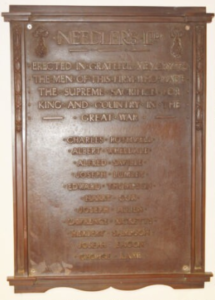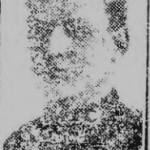
BORN GANSTEAD, HULL, 12/12/1894. SON OF JOHN & EMILY MARY LAMB, OF 17 MAPLE STREET, QUEENS ROAD, HULL. SON OF A BUILDER’S LABOURER. HE HAD THREE BROTHERS AND THREE SISTERS. WORKED AS A GROCER’S CLERK AND FOR NEEDLER’S SWEET FACTORY, AT BOURNEMOUTH STREET, HULL HE ENLISTED IN HULL. SERVED IN THE ROYAL MARINE LIGHT INFANTRY, ATTACHED TO HMS “ALCANTRA”. HE WAS KILLED IN ACTION, DURING BATTLE WITH THE RAIDER “GREIF”, IN THE NORTH SEA, ON 29/02/1916, AGED 21. HIS NAME IS RECORDED ON THE PORTSMOUTH NAVAL MEMORIAL AND THE NEEDLERS WW1 MEMORIAL PLAQUE.
HIS BROTHER, SERGEANT, ALBERT WILSON LAMB, ROYAL FIELD ARTILLERY, WAS KILLED IN ACTION ON 25/08/1917. BOTH BROTHERS WERE RECORDED ON HULL’S, MAPLE STREET & KINGS HALL CHURCH ROLL OF HONOUR, SYMONS STREET, HULL.
The R.M.S.P. Co.´s liner, ALCANTARA, was taken over by the Admiralty at the beginning of the First World War and converted into an auxiliary cruiser. The ship formed one of the 10th Cruiser Squadron and was commanded by Capt. T. E. Wardle, her chief duty being the maintenance of the patrol between Scapa Flow and the coast of Norway. At about mid-day on February 28th, 1916, the position of the ALCANTARA was 60 miles E. of the north of the Shet-lands, where she was to contact her relief ship, the Andes, also an ex R.M.S.P. liner, when a wireless message instructed her to remain thereabouts and keep a sharp look-out for a suspicious steamship coming out of the Skagerrak. At about 8.45 on the following morning Capt. Wardle descried smoke on the horizon on his port beam. He bore up for the stea mship, receiving at the same time a wireless warning from the Andes that this was in all probability the ship he was seeking. The ALCANTARA signalled to the vessel to stop, and fired two rounds of blank ammunition. The ships had approached to within 1,000 yards of each other, the ALCANTARA coming up astern and lowering a boarding boat, when the stranger, which had Norwegian colours painted on her side and her name, Rena—Tonsberg, distinctly visible, dropped her bulwarks and ran out her guns. The British ship was at a disadvantage, though all her guns were manned, and she sustained a tremendous salvo which destroyed her telemotor steering gear, engine-room telegraph and telephones, as well as killing many men, but her guns replied at a range at which it was almost impossible to miss. The ac tion was short but intense, and after some 15 to 20 minutes both ships were in a bad way. The German, which proved to be the raider Greif, was on fire and sinking, while the ALCANTARA had a heavy list to port and was making water so rapidly that Capt. Wardle gave orders to “abandon ship”. She had been hit by a torpedo and gradually capsized, lying keel uppermost for a time, thus affording her crewan opportunity to secure rafts and pieces of wreckage. The Andes, followed by the cruiser Comus and the destroyer Munster, now came upon the scene and picked up the survivors. Meanwhile the Greif had also been abandoned and the cruisers sank her by gunfire. Thus ended one of the most fiercely-fought actions between merchant ships in the First World War. The ALCANTARA lost two officers and 67 men, Capt. Wardle being among the survivors. The total rescued from the Greif was 220 out of a complement of about 300. Read more at wrecksite: https://www.wrecksite.eu/wreck.aspx?11043
